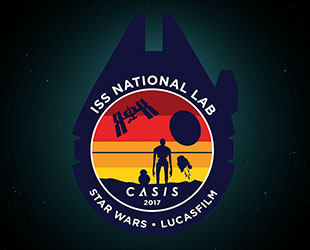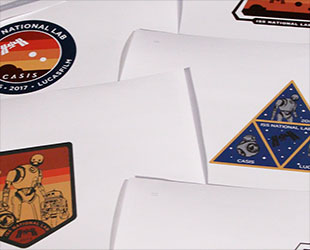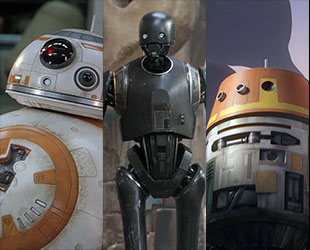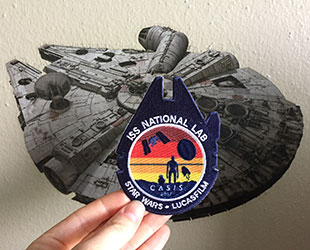September 6, 2017 — That's no moon, it's a space station ...mission patch.
The Death Star, the Millennium Falcon and three popular droids from the "Star Wars" universe appear on an official insignia representing the science now being conducted on the International Space Station (ISS) National Laboratory. The newly-revealed emblem is the product of a partnership between Lucasfilm and the Center for the Advancement of Science in Space (CASIS), the non-profit organization that manages the ISS National Lab.
"We are incredibly excited to link the inspiration brought by 'Star Wars' to our International Space Station, highlighting research that is happening right now in space," Gregory H. Johnson, president and executive director of CASIS and a former NASA astronaut, said in a statement unveiling the mission patch on Wednesday (Sept. 6). "This collaboration connects the scientific promise of the International Space Station to the scientific inspiration of the iconic 'Star Wars' franchise."
The CASIS patch, which derives its overall shape from the Millennium Falcon spaceship and its inner border from the outline of the Death Star, features the droids BB-8, K-2SO and Chopper silhouetted against a sunset and looking out at the International Space Station above. It was developed by Doug Chiang, Lucasfilm's Star Wars vice president and executive creative director, who oversees concept artistry and production design for the films, including the upcoming release, "Star Wars: The Last Jedi," in theaters Dec. 15.

The ISS National Lab 2017 CASIS mission patch. (CASIS) |
"The patch design is meant to evoke this same spirit of wonder when Luke Skywalker looked out to the twin suns of Tatooine," said Chiang. "The silhouetted droids and ISS set against a sunset sky with echoes of the Death Star and Millennium Falcon — two iconic 'Star Wars' vehicles that still captivate us — reflect this memorable scene."
Nearby space station and a galaxy far, far away
"Our job as graphic designers is to simplify things and in this challenge, we had to take something that is an entire Star Wars universe and then also the [real-life] world and blend those two worlds together," said Kelly Smith, the co-owner of Everly Design, who was recruited by Chiang to work on the patch. Smith and her colleague, Stacey Vogel, previously worked with Chiang on the early designs for the "Rogue One" movie title graphic.

Early designs for the "Star Wars"-inspired ISS National Laboratory mission patch included other spaceships and shapes. (CASIS) |
"It was a great opportunity for us to work together again," remarked Chiang in a video clip accompanying the patch's introduction. "The first step was to figure out what were the iconic moments or imagery that we wanted to merge with the space station."
Early drafts of the ISS National Laboratory patch featured the outline of the space station's Cupola and incorporated other vehicles from "Star Wars," like the X-wing starfighter, before arriving at the Millennium Falcon design.
"There is this one scene on Tatooine [in 'Star Wars: A New Hope'], they have that beautiful sunset. We took elements from that and derived our colors for the final piece," Vogel said. "The droids look out into this vast space of discovery and exploration. We felt that that created a wonderment that we can relate to by looking out to the stars."

"Star Wars" droids BB-8 (left), K-2SO and Chopper are featured on the new ISS National Laboratory mission patch. (Lucasfilm) |
The ball-shaped BB-8 astromech droid was introduced in "Star Wars: The Force Awakens" and appears in "The Last Jedi." K-2SO, a humanoid droid, was in "Rogue One," and Chopper, also known as C1-10P, appears on the animated TV series, "Star Wars Rebels."
"The obvious choice was to design [the patch] around the new robots, BB-8, Chopper and K-2," stated Chiang. "That captured everything about the space program. It talked about the future, it talked about the adventure, the longing for the adventure."
Symbol of space station science
"One of the reasons George Lucas created 'Star Wars' was to inspire a sense of romance and adventure of space exploration for a new generation of space explorers," said Chiang. "Growing up, I was always a huge fan of science and space, and if I wasn't in the film business designing for movies, I would hopefully be working for NASA."
Lucasfilm recently announced "Science and Star Wars," a 10-episode web series developed in collaboration with IBM to engage the public on the science associated with the "Star Wars" universe. Coming soon, an episode from this series will be devoted to space ships, and the International Space Station will be prominently featured. The episode will include astronaut Cady Coleman, who spent 159 days aboard the station, and also highlight the types of research and facilities that are associated with the orbiting outpost.

The CASIS 2017 ISS National Laboratory borrows its overall shape from the "Star Wars" Millennium Falcon spaceship. (CASIS) |
For CASIS, the collaboration with Lucasfilm represented an opportunity to draw more attention to the scientific work being done aboard the ISS National Laboratory.
"Traditionally, for NASA related patches, the astronauts themselves have been designing those patches for years. But at the ISS National Laboratory, we try to collaborate with unique partners to help develop these patches, which are representative of all ISS National Lab research during a given year," explained Patrick O'Neill, the marketing and communications director for CASIS.
Previous ISS National Lab mission patches have featured characters from Marvel's "Guardians of the Galaxy" comic book and have been created by celebrity artists, including actor Seth Green.
"This mission patch with Lucasfilm really helps to present a banner year for CASIS and the ISS National Lab as a whole in 2017. We've already had well over one hundred experiments launched to the National Lab, representing a myriad of scientific disciplines," explained O'Neill. "The ISS National Lab is truly a platform for innovation and to have this collaboration with such a recognizable brand is going to bring that research to the forefront even more so."
